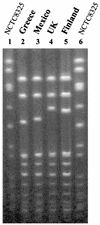Two international methicillin-resistant Staphylococcus aureus clones endemic in a university hospital in Patras, Greece
- PMID: 12734244
- PMCID: PMC154747
- DOI: 10.1128/JCM.41.5.2027-2032.2003
Two international methicillin-resistant Staphylococcus aureus clones endemic in a university hospital in Patras, Greece
Abstract
Pulsed-field gel electrophoresis (PFGE) of SmaI macrofragments and hybridization of ClaI digests with the mecA- and Tn554-specific DNA probes were used to define the endemic clones of methicillin-resistant Staphylococcus aureus (MRSA) among strains collected in 1993 and 1998 to 2000 at the University Hospital of Patras, Patras, Greece. Representatives of each clonal type were analyzed by spaA typing, multilocus sequence typing (MLST), and staphylococcal chromosomal cassette mec (SCCmec) typing. The results indicated the existence of two successive international MRSA clones: (i) a clonal type with PFGE type A, sequence type (ST) 30 (ST30), and SCCmec type IV, which was very similar to a clone widely spread in the United Kingdom, Mexico, and Finland, and (ii) a clonal type with PFGE type B, ST239, and SCCmec III, which was related to the Brazilian clone. Both clones seem to be widespread in Greece as well. A novel MRSA clone is also described and is characterized by a new MLST type (ST80) associated with SCCmec type IV and with the presence of Panton-Valentine leukocidin genes.
Figures



References
-
- Aires de Sousa, M., H. de Lencastre, I. Santos Sanches, K. Kikuchi, K. Totsuka, and A. Tomasz. 2000. Similarity of antibiotic resistance patterns and molecular typing properties of methicillin-resistant Staphylococcus aureus isolates widely spread in hospitals in New York City and in a hospital in Tokyo, Japan. Microb. Drug Resist. 6:253-258. - PubMed
-
- Aires de Sousa, M., M. Miragaia, I. S. Sanches, S. Avila, I. Adamson, S. T. Casagrande, M. C. Brandileone, R. Palacio, L. Dell'Acqua, M. Hortal, T. Camou, A. Rossi, M. E. Velazquez-Meza, G. Echaniz-Aviles, F. Solorzano-Santos, I. Heitmann, and H. de Lencastre. 2001. Three-year assessment of methicillin-resistant Staphylococcus aureus clones in Latin America from 1996 to 1998. J. Clin. Microbiol. 39:2197-2205. - PMC - PubMed
-
- Cox, R. A., C. Conquest, C. Mallaghan, and R. R. Marples. 1995. A major outbreak of methicillin-resistant Staphylococcus aureus caused by a new phage-type (EMRSA-16). J. Hosp. Infect. 29:87-106. - PubMed
-
- Crisostomo, M. I., H. Westh, A. Tomasz, M. Chung, D. C. Oliveira, and H. de Lencastre. 2001. The evolution of methicillin resistance in Staphylococcus aureus: similarity of genetic backgrounds in historically early methicillin-susceptible and -resistant isolates and contemporary epidemic clones. Proc. Natl. Acad. Sci. USA 98:9865-9870. - PMC - PubMed
Publication types
MeSH terms
Substances
LinkOut - more resources
Full Text Sources
Medical
Molecular Biology Databases

